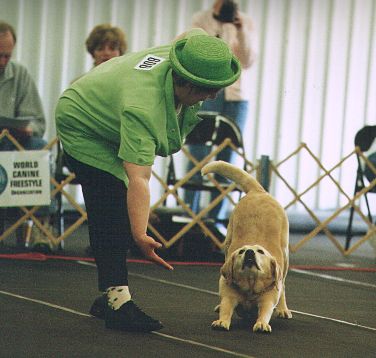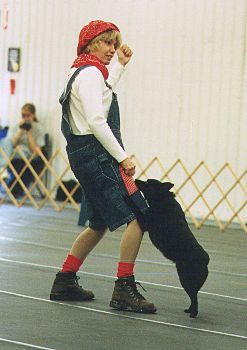|
Dog Dancing--Canine FreestyleDo you and your dog 'make beautiful music' together? Does your pup like to 'get jiggy with it'? Then canine freestyle, also known as dog dancing, might be great fun and exercise for both of you!! 
The First Steps Canine musical freestyle is a sport integrating obedience, tricks, dance, and a whole lot of fun for both handler and animal. Musical freestyling appears to have started in several different places--Canada, England, the United States, and the Netherlands--at around the same time, about 1989. The common bond among these different groups seemed to be a desire to combine a love of music with a more creative style of competitive obedience. Canine freestyle may have also been inspired by a similar equine sport. The first 'official' freestyle organization, Musical Canine Sports International, was started in British Columbia by Terry Fox in 1991. Soon, other groups in other countries sprang up, each with their own unique style of costumes and dance moves. Currently, there are several groups regulating canine freestyle, including the World Canine Freestyle Organization out of Brooklyn, New York (www.worldcaninefreestyle.org); the Canine Freestyle Federation out of Beaverdam, Virginia, and The Musical Dog Sport Association in North America. International groups include Canine Freestyle GB and Pawfect K9 Freestyle Club.
Competition rules vary from country to country, and even group to group, but most are based on various technical and artistic points. For example, British competitions focus more on what's known as 'heelwork', in which the dog stays very close to the handler, almost as if the animal were on a short leash. (Just for the record, leashes are not used.) The animal cannot move far from the handler. Routines can be performed one-on-one (one dog, one handler) or in groups. The key is for the team to move in a manner that fits the rhythm of the chosen music. A routine that does not 'fit' the music will not score high no matter how well-performed it is. The routine can combine a number of moves including leg weaving (where the animal weaves back and forth through the handler's legs as she is dancing) or having the dog and handler move in unison while at a distance. More dramatic tricks, such as jumps, spins, rolls, or bows may be incorporated into the routine. If you watch the faces of the canine performers, you can feel the bond between them and their handlers--and you can also feel the joy they experience. Freestyle is fun for all participants--human or canine!!
Then there's exhibition freestyle, which is what you'll usually see on television. This is a no-holds-barred freestyle which incorporates all the jumps, spins, and other tricks but also includes costumes and props. It's highly entertaining to watch but this kind of freestyle is usually non-competitive.
If you feel you and your CBF have what it takes to compete in freestyle, I would advise that you first work with your pet to teach him to follow your lead from both sides of your body, not just the side you 'heel' on. Any moves that you teach your pup should be broken up into small chunks. For instance, if you want him to follow you for 3 steps backward (you going backward as he follows, facing you) and then to walk in a circle around you, first teach him the three steps following you. Once he's got that down, then add the circle. Most dogs are food-motivated, so using a tiny bit of a tasty treat will have him following your lead in no time. Remember to keep it simple, and if you notice yourself becoming impatient, or he seems bored or frustrated, then it's time to stop the lesson for the day and try again tomorrow. Keep it fun for both of you, and soon you'll both be moving as gracefully as Fred and Ginger!!
|





